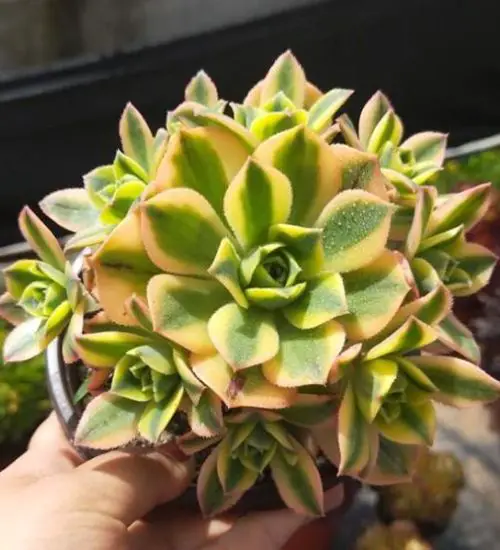Sun: full sun to partial shade
Water: Typical water needs for a succulent
Temperature: Zone 10a from 30° F to 35° F (-1.1 ° C to 1.7° C)
Winter Survival: Winter hardy
Propagation: cuttings
Flower: mid-winter to spring
Flower Type:
Toxic: Generally non-toxic to humans and animals
Dormant: summer
Space Requirement: Indoors & Outdoors
Common Problems: Plants may rot if overwatered, pests
Where to buy Aeonium Starburst?
Basc Care for Aeonium Starburst
Watering
Can you water your succulent more than what its need? The answer is yes and no. In extreme conditions, you can water your plants more often when you notice the soil is completely dry.
One simple tip for you is that you can use some online apps to check the soil status before you go water your succulents. I would recommend the ThePlantsCheck app, it has some nice features there.
Fertilizing
Only feed this succulent during its active growing seasons which means winter. Use the right fertilizer applied in the right amounts. Applying half-strength balanced fertilizer every month or so is recommended for optimal results.
Do not fertilize during summer as the plant is dormant.
Sun & Location Requirements for "lemon-lime plant"
Aeonium Starburst requires full sun to partial shade. It's best to keep it in an area of your garden or home that gets plenty of bright, indirect sunlight throughout the day. When temperatures are too hot and direct sunlight is too intense, try moving "lemon-lime plant" to a shadier spot for part of the day.
As per this succulent profile, it is only able to stay healthy when the environment temperature is above the range of zone 10a from 30° F to 35° F (-1.1 ° C to 1.7° C).
"lemon-lime plant" is a type of plant that can survive in cold, freeze conditions. It has an ability to store water so it can survive even when temperatures drop below freezing. Its strong stems and leaves are also an advantage as they provide extra insulation against the cold weather. The roots of Aeonium Starburst are deep-rooted and can absorb moisture when the air is dry and cold.
Aeonium Starburst is a winter hardy plant that can survive in freeze conditions. Its thick leaves and stems are resistant to extreme temperatures, helping it retain heat and stay alive even through long stretches of cold weather. The roots of "lemon-lime plant" are deep-rooted and can absorb moisture from the air when temperatures drop below freezing. Its ability to store water allows it to survive even through very cold winters.
Any succulents in the group will need a medium space to grow. You can place your pot at your table or window. Since this plant needs more space than mini succulents, you should consider do not plant them together with other succulents/plants.
Aeonium Starburst also benefits from some indirect light throughout the day as well, so make sure you give it enough space to soak up light without becoming too exposed to heat.
Propagation
One way to propagate Aeonium Starburst is by cutting
Toxicity

Aeonium Starburst is not known to pose any significant health risks, as it is not considered to be toxic. However, it is best to keep the plant away from young children and pets, as they may ingest some of the parts of this plant that could contain toxins which can cause mild skin irritation.
Pests and Diseases
Aeonium Starburst can be affected common pests and diseases like most of the other succulents such as aphids, mealybugs, scale insects, and Red spider mites.
If you do spot any of pest signs, you can treat your succulent using below methods.
- Aphids: quarantine, clean infected plants, soapy water.
- Mealybugs: quarantine, clean infected plants, soapy water.
- Scale insects: quarantine, clean infected plants, soapy water.
- Red spider mites: Quarantine, clean your infected plants, treatment with a systemic insecticidal/soapy water.
Besides that, to prevent serious health issues from happening, keep your succulent in a well-ventilated area and check it regularly for any signs of pests or health problems.


